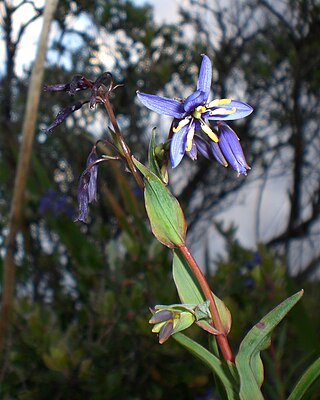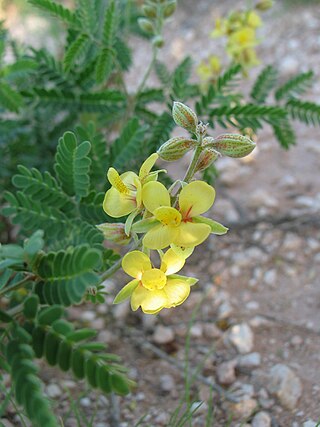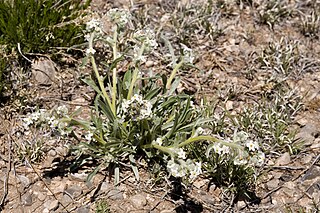
Paronychia is a genus of plants in the family Caryophyllaceae with over 110 species worldwide, mostly from warm-temperate North America, Eurasia, South America and Africa. They are herbs that are annual or biennial or perennial in life span. Some species have a woody base. For the most part they have small, white to yellow-white colored flowers that are often hidden within the paired bracts.

Carex jamesii, known as James's sedge or grass sedge, is a species of sedge native to North America from Minnesota east to New York and south to Oklahoma and South Carolina. It occurs in mesic hardwood forests and produces fruits from early May to mid July. It has two to four perigynia that are subtended by leaf-like pistillate scales. Its seeds are dispersed by ants.

Stypandra is a small genus of rhizomatous perennials in the family Asphodelaceae, subfamily Hemerocallidoideae. They are native to Australia and New Caledonia.

Solanum jamesii is a species of nightshade. Its range includes the southern United States. All parts of the plant, and especially the fruit, are toxic, containing solanine when it matures. The tubers were/are eaten raw or cooked by several Native American tribes, but they require leaching and boiling in clay in order to be rendered edible. The tubers are small when compared to familiar varieties of S. tuberosum.

Eriogonum jamesii is a species of wild buckwheat known by the common name James' buckwheat and antelope sage. It is native to the southwestern United States, being found in: Colorado, Utah, Arizona, Texas, New Mexico, Oklahoma, and Nebraska.

Stypandra glauca, commonly known as the nodding blue lily, is a flowering plant in the family Asphodelaceae. It is a rhizomatous perennial plant with blue lily-like flowers with yellow stamens. It is widespread across southern areas of Australia.

Laxmannia is a genus of tufted perennial herbs in the family Asparagaceae, subfamily Lomandroideae, that are endemic to Australia.

Polanisia is a genus of flowering plants in the family Cleomaceae. Members of the genus are commonly known as clammyweeds. Polanisia jamesii is listed as locally endangered in Minnesota, while P. dodecandra is widespread through much of North America.

Hilaria is a genus of North American plants in the grass family. Members of the genus are commonly known as curly mesquite. They are found in the Southwestern United States, Mexico, and Guatemala.

Thelionema caespitosum, the tufted lily or tufted blue-lily, is a species of perennial herb, native to Australia. The lily-like flowers are blue, light blue, pale yellow or white and have yellow stamens.

Hilaria jamesii is a species of grass known by the common name James' galleta.
S. grandiflora may refer to:

Smilax jamesii is a species of flowering plant in the greenbriar family known by the common name English Peak greenbriar. It is to northern California, where it is known from the Klamath Mountains and the southernmost peaks of the Cascade Range. It has also been reported from nearby locations in southwestern Oregon. It grows in moist areas such as lakesides and streambanks in mountain coniferous forest habitat. It was discovered to be a new species when herbarium specimens thought to be Smilax californica were reexamined.

Pomaria jamesii, commonly known as James' holdback, is a species of plant found in the American southwest.

Blue lily may refer to the following plant species:

Polanisia jamesii, common name James's clammyweed, is a plant species native to the central part of the United States. It is reported from Minnesota, Wisconsin, Ohio, Indiana, Illinois, Iowa, South Dakota, Nebraska, Colorado, New Mexico, Texas and Oklahoma. It generally prefers sandy, disturbed soils. The species is considered locally endangered within the state of Minnesota. The species is also considered locally endangered within the state of Illinois.
Hymenoxys jamesii is a North American species of flowering plant in the daisy family known by the common name James's rubberweed. It has been found only on the Mogollon Plateau of Arizona in the southwestern United States.

Telesonix is a genus of flowering plants belonging to the family Saxifragaceae.

Oreocarya suffruticosa is a species of flowering plant in the family Boraginaceae, native to the west and central United States and to northern Mexico. It was first described by John Torrey in 1827 as Myosotis suffruticosa and transferred to Oreocarya by Edward Lee Greene in 1887. Varieties of Oreocarya suffruticosa have previously been placed within several species of Cryptantha, including Cryptantha cinerea, Cryptantha jamesii and Cryptantha pustulosa.















